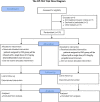Comparing the effects of dexmedetomidine versus propofol on the treatment of emergence agitation in adult patients after general anesthesia: study protocol for a randomized, superiority, controlled trial (DP-TEA Trial)
- PMID: 34784941
- PMCID: PMC8593636
- DOI: 10.1186/s13063-021-05743-2
Comparing the effects of dexmedetomidine versus propofol on the treatment of emergence agitation in adult patients after general anesthesia: study protocol for a randomized, superiority, controlled trial (DP-TEA Trial)
Abstract
Background: Emergence agitation (EA) after general anesthesia is a common complication in the post-anesthesia care unit (PACU). Once EA occurs, there are still no guidelines established for the treatment in adults. Propofol is excessively used in managing agitated patients in the PACU, but it lacks analgesia and can result in apnea. Intraoperative infusion of dexmedetomidine has been proven to have a preventive effect on EA, but the treatment effect of dexmedetomidine on EA remains unknown. This study aims to compare the effects between dexmedetomidine and propofol on relieving EA in adult patients after general anesthesia in the PACU.
Methods: In this randomized, superiority, controlled clinical study, a total of 120 adult patients aged 18-65 years of both genders, with American Society of Anesthesiologists (ASA) classification I or II developing EA in the PACU after general anesthesia, will be enrolled. Patients will be randomized at a 1:1 ratio into two groups, receiving either a single dose of dexmedetomidine (0.7μg/kg) or propofol (0.5 mg/kg). The primary outcome is the proportion of patients having a recurrent EA within 15 min after intervention in the PACU.
Discussion: Previous studies have focused on premedication for preventing EA, while therapeutics for reliving EA have rarely been reported. To our knowledge, this study is the first randomized, superiority, controlled trial to compare a bolus of dexmedetomidine with the current routine care for this indication.
Trial registration: ClinicalTrials.gov NCT04142840 . Registered on October 26, 2019.
Keywords: Adult patient; Dexmedetomidine; Emergence agitation; Propofol.
© 2021. The Author(s).
Conflict of interest statement
The authors declare that they have no competing interests.
Figures


Similar articles
-
Remifentanil is Superior to Propofol for Treating Emergence Agitation in Adults After General Anesthesia.Drug Des Devel Ther. 2024 Feb 7;18:341-350. doi: 10.2147/DDDT.S433155. eCollection 2024. Drug Des Devel Ther. 2024. PMID: 38344258 Free PMC article.
-
Remimazolam vs. propofol for induction and maintenance of general anesthesia: A systematic review and meta-analysis of emergence agitation risk in surgical populations.J Clin Anesth. 2025 Apr;103:111815. doi: 10.1016/j.jclinane.2025.111815. Epub 2025 Mar 22. J Clin Anesth. 2025. PMID: 40120546
-
Effects of peri-operative intravenous administration of dexmedetomidine on emergence agitation after general anesthesia in adults: a meta-analysis of randomized controlled trials.Drug Des Devel Ther. 2019 Aug 15;13:2853-2864. doi: 10.2147/DDDT.S207016. eCollection 2019. Drug Des Devel Ther. 2019. PMID: 31496661 Free PMC article.
-
Postoperative propofol bolus treatment did not affect recovery time in patients with emergence agitation after sevoflurane anesthesia in pediatric patients undergoing strabismus surgery: Prospective nonrandomized case-control study.Medicine (Baltimore). 2022 Jul 15;101(28):e29521. doi: 10.1097/MD.0000000000029521. Medicine (Baltimore). 2022. PMID: 35838993 Free PMC article.
-
Perioperative dexmedetomidine reduces emergence agitation without increasing the oculocardiac reflex in children: A systematic review and meta-analysis.Medicine (Baltimore). 2021 May 7;100(18):e25717. doi: 10.1097/MD.0000000000025717. Medicine (Baltimore). 2021. PMID: 33950954 Free PMC article.
Cited by
-
Remifentanil is Superior to Propofol for Treating Emergence Agitation in Adults After General Anesthesia.Drug Des Devel Ther. 2024 Feb 7;18:341-350. doi: 10.2147/DDDT.S433155. eCollection 2024. Drug Des Devel Ther. 2024. PMID: 38344258 Free PMC article.
-
Risk factors for emergence agitation during the awakening period in elderly patients after total joint arthroplasty: a retrospective cohort study.BMJ Open. 2023 May 10;13(5):e068284. doi: 10.1136/bmjopen-2022-068284. BMJ Open. 2023. PMID: 37164475 Free PMC article.
References
Publication types
MeSH terms
Substances
Associated data
Grants and funding
LinkOut - more resources
Full Text Sources
Medical

